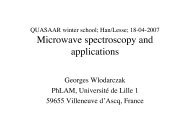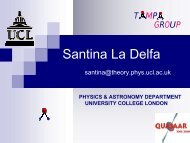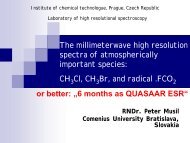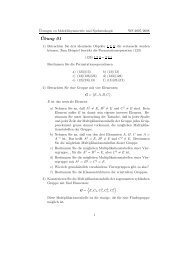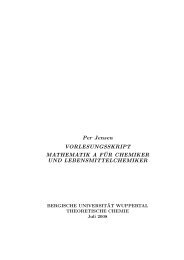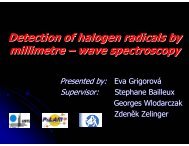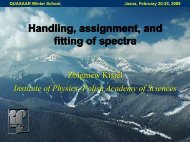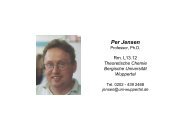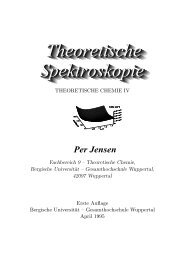Abstract book - Prof. Per Jensen, Ph.D. - Bergische Universität ...
Abstract book - Prof. Per Jensen, Ph.D. - Bergische Universität ...
Abstract book - Prof. Per Jensen, Ph.D. - Bergische Universität ...
- No tags were found...
You also want an ePaper? Increase the reach of your titles
YUMPU automatically turns print PDFs into web optimized ePapers that Google loves.
Contributed Lectures, N10 231Line mixing effects in CO 2 spectra modelled by an Energy-CorrectedSudden approachLeila Daneshvar and Jeanna BuldyrevaDaneshvar L.Buldyreva J.Institut UTINAM UMR CNRS 6213, Université de Franche-Comté, 16 Route de Gray,25030 Besançon cedex, FranceThe important role played by the carbon dioxide CO 2 in the terrestrial and planetaryatmospheres has initiated numerous spectroscopic studies of this molecule. One offeatures related to its infrared absorption spectra modelling is the important lineoverlapping due to the small value of the rotational constant and occurring in the Q-branches even at low pressures and in all the branches at elevated pressures. As a result,the spectral intensity exhibits a significant deviation from the simple sum of Lorentzianlines corresponding to the isolated lines, and its reliable modelling requires including ofline-mixing effects.From the theoretical point of view, the description of line interference is based on thenotion of the relaxation matrix which diagonal elements (real and imaginary parts)correspond to the half-widths and shifts of individual lines whereas the off-diagonalelements describe the intensity transfer between the lines. Since the calculation of theseoff-diagonal elements by quantum-mechanical methods from the interaction potentialrepresents a very time-consuming computational task, they are commonly modelledwith dynamical scaling laws, such as, for example, the Energy-Corrected Sudden (ECS)approach proposed by De Pristo et al. [1] for the Q-branches of isotropic Ramanscattering in the framework of the impact approximation (frequency-independentrelaxation matrix). This model ensures a more realistic dynamics with respect to themodels of instantaneous collisions (such as Infinit-Order Sudden approximation) via acorrective “adiabaticity factor” introducing the final duration of collisions and providesa good description of overlapped lines near their centres.In the far spectral wings, however, the role of photon is no more negligible and therelaxation matrix becomes essentially dependent on the photon frequency (so-callednon-Markovian matrix). Such a non-Markovian model of the relaxation matrix hasdeveloped a decade ago [2,3] and successfully applied to the high-density Ramanscattering spectra of N 2 [3,4] and CO 2 [5,6].In the present work we adapt and apply this ECS model to infrared absorption spectra ofpure CO 2. For the considered low-pressure spectra we focalise our modelling of the Q-branches where the impact approximation is valid and the non-Markovian effects arenegligible.References[1] A.E. De Pristo et al., J. Chem. <strong>Ph</strong>ys. 71, 850 (1979).[2] A.P. Kouzov, <strong>Ph</strong>ys. Rev. A 60, 2931 (1999).[3] J.V. Buldyreva, L. Bonamy, <strong>Ph</strong>ys. Rev. A 60, 370 (1999).[4] L. Bonamy, J.V. Buldyreva, <strong>Ph</strong>ys. Rev. A 63, 012715 (2000).[5] S. Benec’h et al., J. Raman Spectrosc. 33, 934 (2002).[6] L. Daneshvar, J. Buldyreva, Mol. <strong>Ph</strong>ys. 2012. DOI:10.1080/00268976.2012.683458




